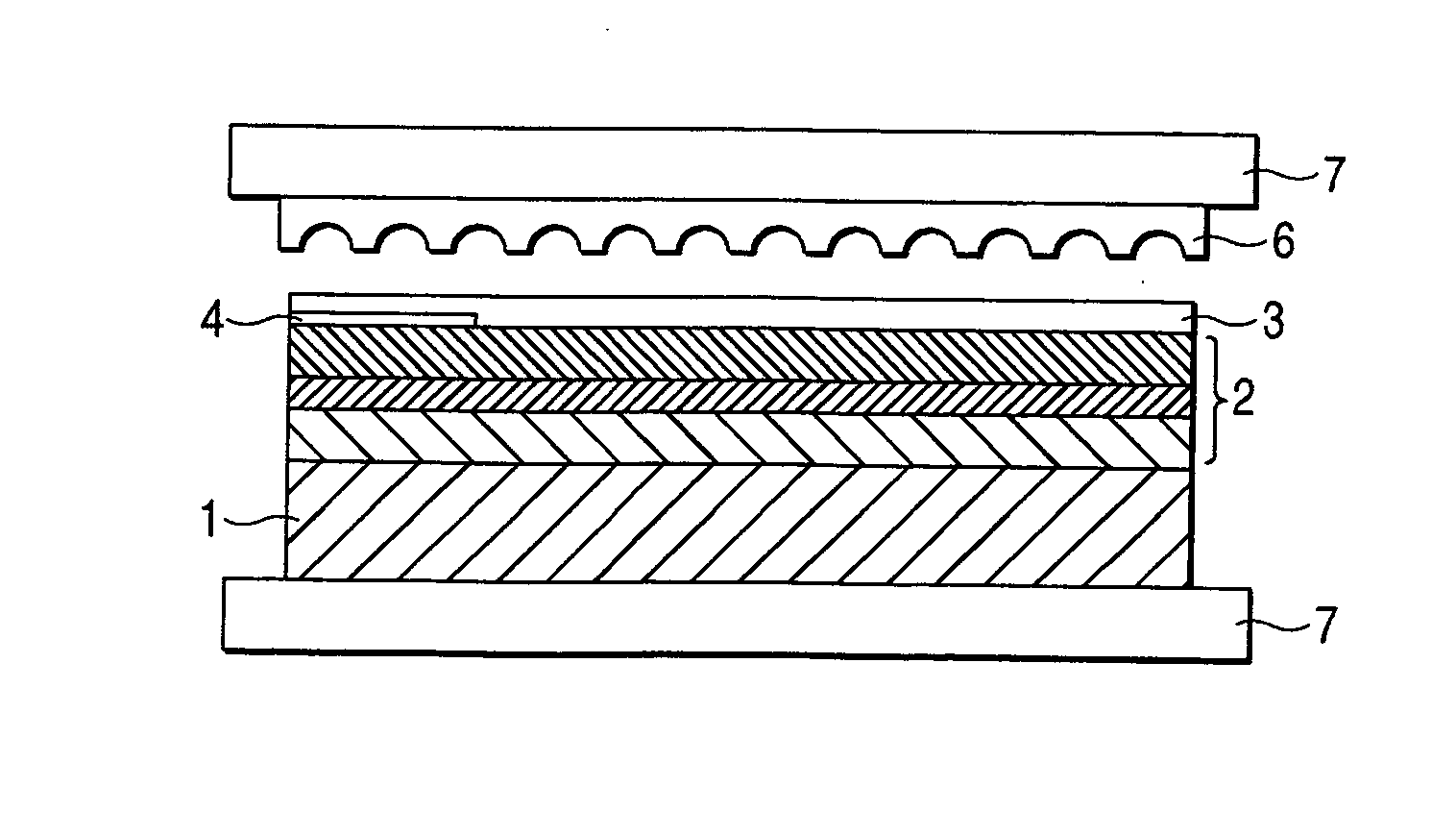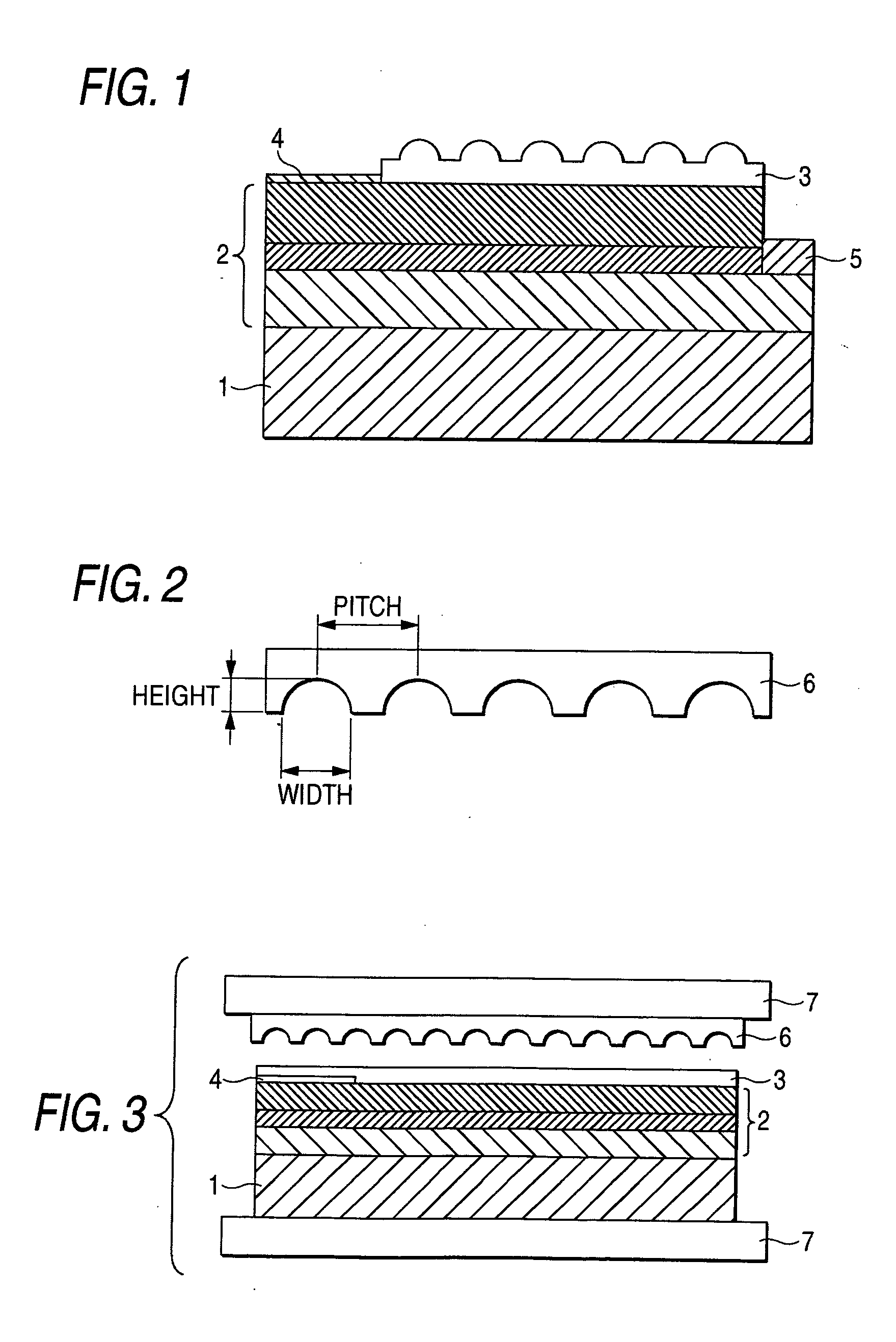Process for producing light-emitting semiconductor device
a technology of semiconductor devices and semiconductor elements, applied in the direction of coatings, optical articles, other domestic articles, etc., can solve the problems of damage to light-emitting semiconductor elements, troublesome steps, cost, etc., and achieve the effect of satisfying the efficiency of light takeou
- Summary
- Abstract
- Description
- Claims
- Application Information
AI Technical Summary
Benefits of technology
Problems solved by technology
Method used
Image
Examples
production example 1
Production of Polycarbodiimide:
[0078] Into a 500-mL four-necked flask equipped with a stirrer, dropping funnel, reflux condenser, and thermometer were introduced 29.89 g (171.6 mmol) of tolylene diisocyanate (isomer mixture; T-80, manufactured by Mitsui-Takeda Chemical), 94.48 g (377.52 mmol) of 4,4′-diphenylmethane diisocyanate, 64.92 g (308.88 mmol) of naphthalene diisocyanate, and 184.59 g of toluene. These ingredients were mixed together.
[0079] Thereto were added 8.71 g (51.48 mmol) of 1-naphthyl isocyanate and 0.82 g (4.29 mmol) of 3-methyl-1-phenyl-2-phospholene 2-oxide. The resultant mixture was heated to 100° C. with stirring and held for 2 hours.
[0080] The end point of the reactions was ascertained by IR analysis and the reaction mixture was cooled to room temperature. Thus, a polycarbodiimide solution was obtained. In this polycarbodiimide, 100% by mole of the diisocyanate residues were aromatic diisocyanate residues. This polycarbodiimide was represented-by formula (1...
production example 2
Production of Polycarbodiimide Sheet:
[0083] The polycarbodiimide solution obtained in Production Example 1 was applied to a separator (thickness, 50 μm) (manufactured by Toray Industries, Inc.) made of poly(ethylene terephthalate) treated with a release agent (fluorinated silicone). The solution applied was heated at 130° C. for 1 minute and then heated at 150° C. for 1 minute. The separator was removed to obtain a temporarily cured sheet-form polycarbodiimide (thickness, 20 μm).
example 1
Production of Light-Emitting Semiconductor Devices:
[0084] An element (diameter, 100 mm; thickness, 100 μm) was prepared which had been obtained by forming a GaN layer on a sapphire substrate and forming an electrode (gold electrode) on the GaN layer.
[0085] The coating fluid produced in Production Example 1 was applied on the surface of the element by spin coating (5,000 rpm; 60 seconds) and dried at 120° C. for 30 minutes with a non-circulating drying oven to form a polycarbodiimide layer having a thickness of 2 μm.
[0086] Subsequently, a die made of nickel (110 mm×110 mm) was prepared which had semispherical recesses each having a width of 4 μm and a height of 2 μm at a pitch of 6 μm as shown in FIG. 2.
[0087] The die 6 and the light-emitting semiconductor element having thereon the polycarbodiimide layer were set between the heated pressing plates 7 of a pressing type vacuum laminator (V130, manufactured by Nichigo-Morton Co., Ltd.) as shown in FIG. 3. The element having the po...
PUM
| Property | Measurement | Unit |
|---|---|---|
| thickness | aaaaa | aaaaa |
| refractive index | aaaaa | aaaaa |
| height | aaaaa | aaaaa |
Abstract
Description
Claims
Application Information
 Login to View More
Login to View More - R&D
- Intellectual Property
- Life Sciences
- Materials
- Tech Scout
- Unparalleled Data Quality
- Higher Quality Content
- 60% Fewer Hallucinations
Browse by: Latest US Patents, China's latest patents, Technical Efficacy Thesaurus, Application Domain, Technology Topic, Popular Technical Reports.
© 2025 PatSnap. All rights reserved.Legal|Privacy policy|Modern Slavery Act Transparency Statement|Sitemap|About US| Contact US: help@patsnap.com


